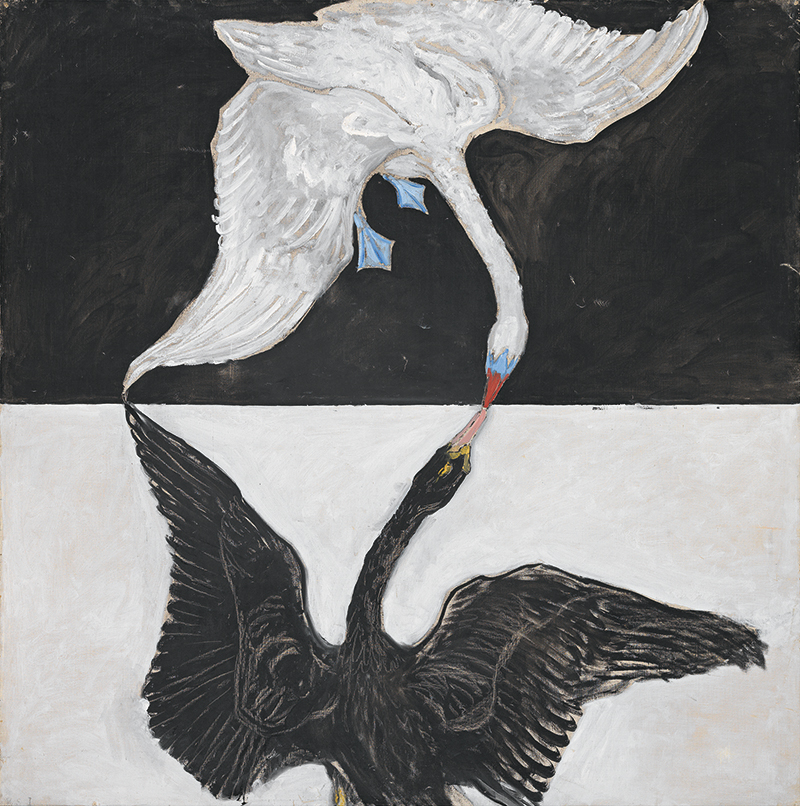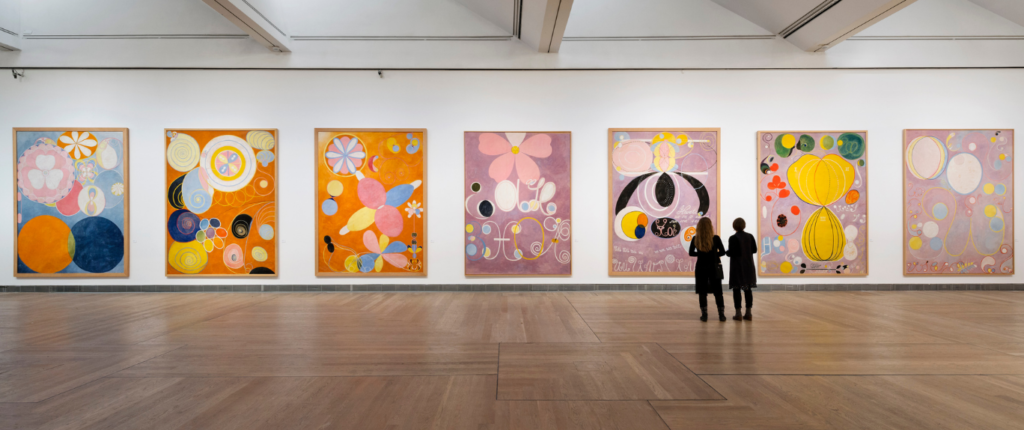Originally published in Art News Winter 2021. Read the article here.

Swedish artist–mystic Hilma af Klint accepted her ‘great commission’ from the spirit guide Amaliel on 1 January 1906. For the next nine years and across the 193 works of the Paintings for the Temple cycle, she channelled and interpreted images and messages communicated to and through her for humanity. This was a vast, holistic project with an even bigger ambition—to radically transform society. This did not happen, but there were radical outcomes. Af Klint created an entirely new artistic language—possibly even abstraction itself—through a fusion of occult, scientific, and painterly modes of investigation that let her reach beyond the visible world. Af Klint would later decree that her work—unheralded and virtually unseen in its own time—was to be hidden away for twenty years after her death. It was to be saved for a more enlightened future.
Made at the outbreak of World War I, Group IX/SUW is one of the darkest and most violent series in the cycle. It starts with a mirrored image of a black swan and a white swan, with the tips of their wings and beaks touching at the centre of a canvas divided into two parts. Over twenty-four paintings, the swans dissolve and morph into a series of abstract, geometric forms resembling spinning colour wheels, tesseracts, and mandalas—all humming with that vibrational energy which af Klint believed held the power to transcend dualities and unite the ethereal and earthly realms.
The swan is an important symbol in af Klint’s work. It has also come to symbolise the project that has brought her work to Australasia for the first and likely only time, in the exhibition Hilma af Klint: The Secret Paintings, curated by Sue Cramer for the Art Gallery of New South Wales and City Gallery Wellington. It is the black swan that especially resonates with the project’s insistence on the importance and relevance of af Klint’s work for the here and now. The black swan is endemic to Australasia, belonging more to us than to af Klint’s painting. It isn’t too much of a stretch to read its presence there as a call across time and space from af Klint’s work to us in twenty-first century Australasia. To enter her universe is to enter a world of alternative possibilities—to accept that art can be and do more. She speaks to us in other ways.
Filmmaker Halina Dyrschka is one of many who have heard the call of af Klint’s paintings. Her statement—‘they spoke to me more profoundly than any art I have ever seen … It felt like a personal insult that these paintings had been hidden from me for so long’—captures a wider response to af Klint’s work and its offer of an authentic, profoundly moving, yet personalised art experience. Dyrschka’s documentary Beyond the Visible: Hilma af Klint (2019) attempts to reconcile all the questions and feelings that contemporary viewers bring to the work. Its reconstructions of af Klint making The Ten Largest on the floor of her studio are particularly satisfying. They address the perennial question of just how she was able to physically make these monumental works, charting the spiritual development of humanity from childhood, youth, and adulthood to old age. It says a lot about the power of these paintings as objects that questions about how they were made remain as pressing as those related to more complex issues around their mode of spiritual transmission—or even how any of this was possible in a cultural context that severely restricted the creative possibilities for women artists. These scenes also feel like a slap to Hans Namuth’s film celebrating Jackson Pollock’s supposedly revolutionary act of taking his painting off the easel and working in and on it on the floor—almost fifty years later.
Af Klint’s work has become a cultural phenomenon. Film, music, fashion, and literature are competing with each other, and with contemporary art and art history, to find the most authentic ways of recognising and responding to her work. Behind this appeal is something deeper and more pressing. Af Klint’s popularity is bound up with the cultural anxieties of our times. Her quest to forge a new form of spirituality through art that can shift entrenched materialistic and binary modes of thought and being resonates strongly now. We project as much onto her as our spiritual and artistic guide as she does onto us as her enlightened future audience.
Yet af Klint’s work is never preachy or prosaic. It is cryptic, puzzling, and challenging—full of diagrams, codes, charts, and forms of arcane knowledge. Part of the charge it carries is that we are still figuring it all out. In one way, we are still part of the first audience for the work. Six-hundred-thousand visitors may have attended the blockbuster exhibition at the Guggenheim Museum in 2018, echoing earlier record-breaking shows at the Serpentine Gallery and Moderna Museet, but, even when all of these numbers are added, there have been far fewer eyeballs on af Klint’s work than on those ‘modernist masters’ of her age. Now we are all looking and collectively working through af Klint’s art as both a historical and a contemporary force.
Hilma af Klint: The Secret Paintings participates in this process. The first survey outside of Sweden since the Guggenheim, this the farthest af Klint’s work has travelled beyond Europe and its histories and canons. Might the habitat of the black swan bring new understandings to af Klint’s art? You feel that possibility when passing two paintings by senior Pitjantjatjara artists and ngangkari (traditional healers) Betty Muffler and Maringka Burton on the way to the exhibition inside the Art Gallery of New South Wales. Part of The National, a multi-venue survey of contemporary Australian art, these paintings also recognise af Klint’s quest to push beyond the concrete to the spiritual by accessing elemental forces of nature and modes of received knowledge. Roughly the same size as those in The Ten Largest, these paintings employ a landscape format to connect to country, where af Klint’s portrait format transports us to the astral plane. Af Klint’s abstraction has been discussed in relation to tantric traditions (theosophy’s interest in comparative world religions would have guided her here), but the proximity this project establishes between her work and Aboriginal, Māori, and Pacific art opens a new range of possibilities. In Aotearoa, we may find new connections embedded in Fiona Pardington’s photographic animism or in the contemporary cosmological explorations of Nikau Hindin or Maioha Kara.
The discussion around af Klint herself is also shifting. The first catalogue raisonné and a biography have recently been published. Julia Voss’s biography, especially, challenges the narratives that have built around the artist. We now know that af Klint was not working in total isolation from the currents of modernism—she travelled, visited exhibitions, and even participated in one alongside Wassily Kandinsky. Voss also traces af Klint’s efforts to find an audience in her own time. It was only late in life and disillusioned with responses to her work that she decreed that it was destined for a future audience. Meanwhile, interest is starting to radiate outwards to other figures in her story. Cornelia Cederberg is emerging as a fascinating figure in her own right, rather than just being listed as one of the Five—af Klint’s early spiritualist group that opened her connection to the spirit world through art making. We now know that Cederberg assisted af Klint with the Paintings for the Temple cycle. She prepared canvases, mixed paints, and possibly assisted with the painting of what is normally presented as af Klint’s solitary, secretive pursuit.
None of this new information dispels the intrigue or importance of af Klint’s art. In fact, it has the opposite effect. It forces us—an audience in whom she invested so much potential—to look and think harder. We are in the process of pushing beyond the ‘female pioneer of abstraction’ line that has elevated af Klint into the discussion but can only take our understanding of the work so far. Af Klint’s art still holds many secrets and possibilities. This is one of the reasons artists today are so drawn to it. In Aotearoa, Kathy Barry’s transcendental geometries, Jen Bowmast’s artist-as-querent mode, Areez Katki’s embroidered cultural transmissions, Grace Wright’s expansive abstractions, and Georgie Hill’s diagrammatic watercolours are examples of art calling to af Klint’s from the here and now. The black swan and the white swan are touching again.

Hilma af Klint: The Secret Paintings, curated by Sue Cramer, Art Gallery of New South Wales, Sydney, 11 June–19 September 2021, and City Gallery Wellington, 4 December 2021–17 March 2022.
